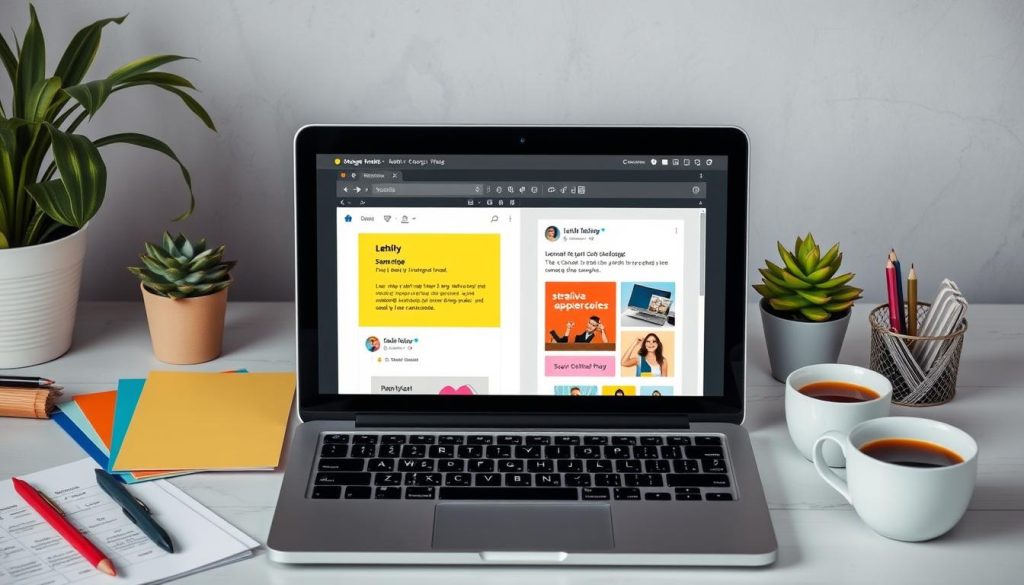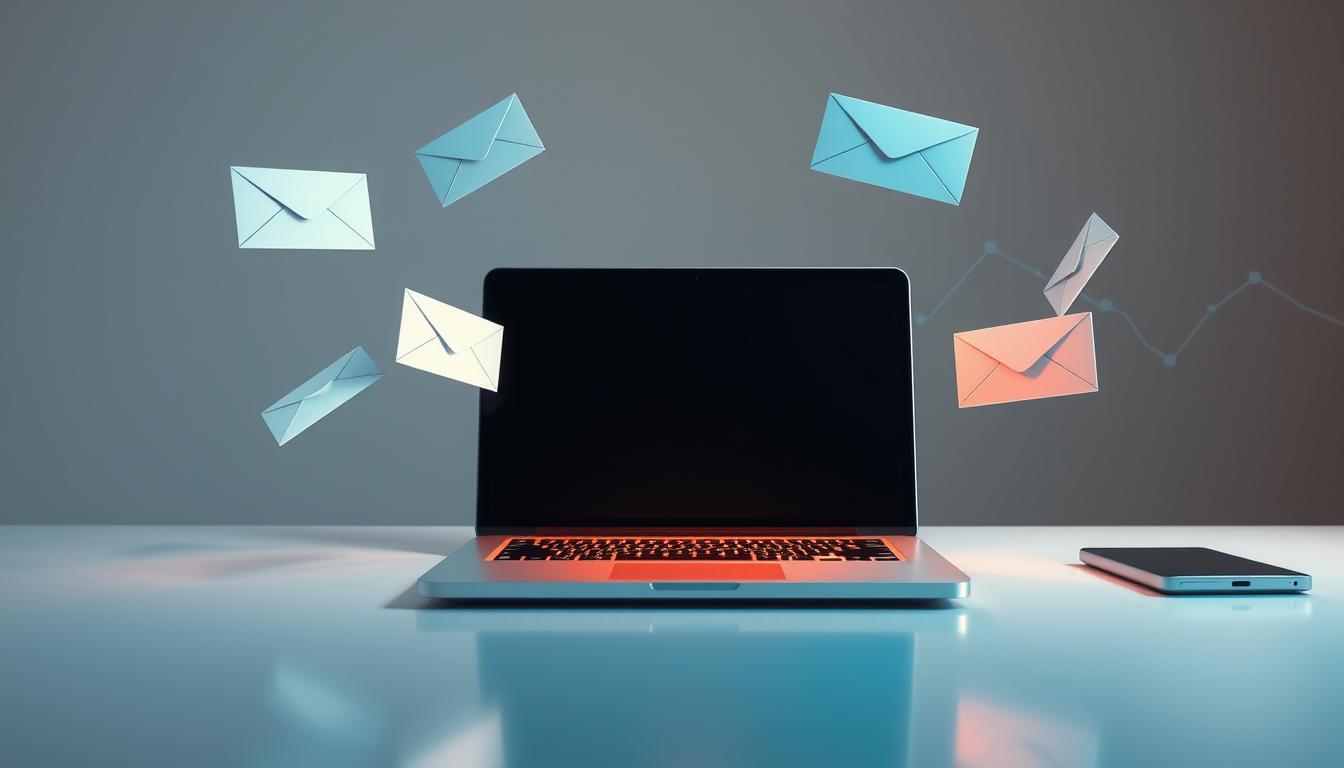Emails are a common way to communicate, with over 319.6 billion sent daily. Some are personal, while others are from businesses trying to find new customers. If you’re sending a cold email, it’s important to know the risks. If you’re not careful, your email could be seen as spam and you might get blocked.
This article will guide you on how to send cold emails without trouble. We’ll cover what you should do and what to avoid. This way, your message will reach its destination without any issues.
Key Takeaways
- Over 319.6 billion emails are sent every day, making it crucial to understand how to properly send cold emails.
- Cold emails are unsolicited messages used in business settings to reach potential customers without a large budget.
- Email providers have measures to prevent spam messages from reaching inboxes, so it’s important to maintain a good sender reputation.
- Warming up a new email account and avoiding spam-triggering words are essential to prevent IP flagging.
- Properly authenticating your emails, verifying your email list, and monitoring sending volume are key to successful cold email campaigns.
Understanding Cold Emails and Deliverability
Cold emails are a key tool in today’s business world. They are unsolicited messages sent to people without any prior contact. This method can be a good way to introduce your product or service to new audiences.
What is a Cold Email?
A cold email is a message sent to someone you’ve never met before. It’s often used in business to reach out to potential customers or partners. The goal is to grab their interest and start a conversation.
What is Deliverability?
Deliverability means your email will actually get to the person’s inbox. Email providers check if your email meets certain standards. They look at things like who you are, what you’re saying, and if you’re following email marketing rules.
Benefits of Cold Emails
Cold emails have many benefits for businesses and individuals. They are:
- Not requiring a large budget: Cold emailing is affordable, allowing you to reach out without spending a lot.
- Accessing decision-makers: Cold emails can help you get in touch with important people who might be hard to reach otherwise.
- Standing out from the competition: A well-written cold email can make you stand out in a crowded market.
Understanding cold emails and deliverability helps businesses use this tool effectively. It can lead to meaningful connections with their audience.
What Causes IP Flagging in Cold Email Campaigns?
Effective cold email outreach depends on a good sender reputation and avoiding IP flagging. Several factors can lead to IP flagging, affecting your message delivery. Let’s look at the main reasons for this issue.
Bad Sender Reputation
Your “sender reputation” is your emailing history. Email providers check it to decide if they should deliver your messages. If your score is too low, your messages might be seen as spam or blocked.
Spammy Content and Trigger Words
Email providers also look for signs of spam in your messages. They watch out for trigger words like “free,” “win,” and “sale.” Too much of this can cause IP flagging.
“Businesses that send 5,000 emails or more to personal Gmail accounts within 24 hours are classified as bulk senders by Google.”
To prevent IP flagging and keep a strong sender reputation, write your cold email messages carefully. Avoid any language or content that might be seen as spam.
How to Prevent IP Flagging in Cold Email Campaigns
To run successful cold email campaigns, you need a smart plan. This plan helps keep your sender reputation high and avoids IP flagging. Use a trusted email service provider, authenticate your emails, and slowly warm up your account. This way, your cold emails are more likely to land in the inbox, not the spam folder.
Use a Reputable Email Service Provider
Choosing a reliable email service provider (ESP) is key to avoiding IP flagging. Good ESPs have advanced tools to spot spam and phishing. They also follow email laws closely. Using their services helps your cold emails get to the right people’s inboxes.
Authenticate Your Emails
Using email authentication like SPF, DKIM, and DMARC boosts your cold email’s delivery. These steps prove your domain and sender are real. This lowers the spam flag chances on your emails.
Warm Up Your Email Account
Building up your email account’s activity and reputation is vital. Start with a few cold emails and slowly send more. This “warming up” lets email providers see you as a real sender, not a spammer. Keep a steady sending schedule and watch your engagement to improve your reputation.
With these steps, you can dodge IP flagging and make your cold email campaigns more effective. This means better results for your business.
Creating a Targeted Prospect List
Creating a targeted prospect list is key for cold email success. Sending generic emails to many people won’t work. Instead, focus on a list of potential customers who might be interested in what you offer.
We can use tools like Saleshandy’s Lead Finder to build this list. It gives access to over 750 million professional profiles across 60 million companies. This way, we can target the right people in our ideal customer profile.
It’s also important to research our target market well. We should know the pain points and needs our solution can solve. This helps us send personalized messages that really speak to our prospects.
Remember, a good list is more important than a big one. Even though cold email reply rates are low, a targeted list boosts our chances. It also helps us avoid being seen as spam.
| Best Practices for Building a Targeted Prospect List | Strategies to Avoid |
|---|---|
|
|
By following these tips and avoiding common mistakes, we can make a list that boosts our cold email success. This helps us avoid being flagged as spam.
Verifying Email Addresses and List Hygiene
Keeping your email list clean and verified is key for cold email success. Sending to wrong or unused email addresses harms your reputation and can get your account blocked. By checking and cleaning your list, you make sure your emails reach the right people and work better.
Importance of Email List Verification
Verifying email addresses is vital for a healthy list. It helps your cold emails perform better. By checking your list, you can spot and remove bad contacts. This keeps your emails from bouncing and protects your reputation.
Removing Invalid and Inactive Emails
- Invalid emails: These are addresses that don’t exist or are not active. Sending to them causes hard bounces, hurting your delivery.
- Inactive emails: These are addresses that haven’t been used for a long time. People who don’t engage with you are less likely to reply to your emails. It’s best to remove them.
By regularly checking and cleaning your list, you keep your database top-notch. This boosts your cold email campaigns’ success.
“Verifying email addresses and maintaining a clean email list is essential for the success of any cold email campaign. Neglecting this crucial step can lead to high bounce rates, damaged sender reputation, and ultimately, poor campaign performance.”
Personalization and Engaging Content
In the world of cold emailing, making your message personal is key. It ensures your emails not only get to your prospects but also grab their attention. By personalizing your content, you create messages that speak directly to each person, avoiding the generic emails that often get lost in spam.
Avoiding Spam Trigger Words
Steering clear of spam trigger words is crucial for personalization. These words can set off spam filters, making it harder for your emails to reach their destination. Words like “free,” “guarantee,” or “limited time offer” should be used carefully in your cold email campaigns.
Writing Value-Oriented Emails
Instead of sending out sales-heavy emails, focus on sending value-oriented ones. These emails should offer real insights or solutions that meet your prospects’ needs. By showing you understand their challenges and providing useful information, you can build stronger connections and boost engagement.
Studies show that businesses that personalize their emails can see up to a $20 return for every $1 spent. Personalized emails also have an 82% higher open rate than generic ones. To truly connect with your prospects, use advanced personalization techniques. This includes referencing their past work, clients, software, marketing activities, and interests.
| Personalization Level | Recommended Approach |
|---|---|
| Small Deal Size Prospects | Basic personalization involving adding their name, industry, and organization name. |
| Medium Deal Size Prospects | Semi-personalization, including organizational or personal achievements and shared interests. |
| Large Deal Size Prospects | Hyper-personalization, involving in-depth research to address their specific pain points, challenges, and accomplishments. |
By tailoring our cold email campaigns to our prospects’ specific needs, we can improve deliverability and build stronger relationships. The key is to keep testing and refining our personalization strategies. Always put your audience’s needs first in your efforts.

Monitoring Sending Volume and Limits
Keeping an eye on your daily sending limits is key for cold email campaigns. Unlike marketing emails, cold emails have strict limits. Sending too many can trigger spam filters and harm your reputation.
Understanding Daily Sending Limits
The average email deliverability rate is about 85%. However, this can change based on the email provider and industry. For example, Gmail has a high deliverability rate of 88.1%, while Apple’s is 66.3%.
To make sure your emails reach their destination, send no more than 50 emails per day. This is especially important when using a new email address.
Sending Emails at Random Intervals
- Sending all your cold emails at once can trigger spam filters and make your outreach appear less natural.
- Instead, aim to send your emails at random intervals throughout the day to mimic the behavior of a human user.
- This approach helps avoid raising any red flags and keeps your email deliverability high.
By monitoring your email sending volume and limits, you can keep your campaigns effective and compliant. This boosts your chances of successful outreach.
Avoiding Common Cold Email Mistakes
As a savvy marketer, you know cold emailing is powerful. But, some actions can trigger spam filters and harm your reputation. It’s key to avoid these mistakes for successful campaigns.
Misleading Subject Lines
Using misleading or clickbait subject lines is a big mistake. They don’t match the email’s content. This can upset recipients and make them mark your emails as spam, hurting your delivery rate.
Excessive Links in Emails
Another mistake is putting too many links in your emails. Spammers use lots of links to get website traffic, which spam filters don’t like. Try to include just enough links to interest the recipient without overwhelming them.
- Avoid using deceptive or sensationalized subject lines that don’t accurately represent your email’s content.
- Limit the number of links in your cold emails, focusing on including only the most essential and valuable information.
- Regularly monitor your email performance and adjust your strategies to prevent common cold email mistakes.

By avoiding these common mistakes, your cold email campaigns will stay effective. You’ll build trust with your recipients and keep a strong reputation as a sender.
Maintaining Email Compliance
Marketers know the value of cold emailing to find new customers. But, we must follow the law and best practices. The CAN-SPAM Act is key, as it guides commercial email rules.
CAN-SPAM Act and Legal Requirements
The CAN-SPAM Act requires a clear unsubscribe link in commercial emails. This lets people choose not to get more emails. Not following this can lead to big fines and harm your reputation. By offering an easy way to unsubscribe, we show we respect people’s choices and are open in our marketing.
Including an Unsubscribe Link
- Put a clear and easy-to-find unsubscribe link in every cold email.
- Make sure the unsubscribe process is simple, so people can opt-out quickly.
- Keep an eye on unsubscribe requests and act fast to stay compliant.
Following email rules is not just a must; it’s also key to gaining trust and credibility. By following the CAN-SPAM Act and offering a clear way to unsubscribe, we show we’re committed to fair marketing. This helps us build strong, lasting relationships with our prospects.
“Maintaining email compliance is essential for the long-term success of your cold email campaigns. It’s not only a legal requirement but also a way to build trust and credibility with your audience.”
Conclusion
To improve cold email success, follow key steps. Use a trusted email service and authenticate your emails. Also, warm up your account and create a targeted list. Personalize your content and stay compliant with email rules.
By doing these, we can avoid IP flagging and boost our email delivery. It’s important to be strategic with cold emailing. Avoid mistakes that can harm our reputation and trigger spam filters.
With 72% of people preferring email to talk to businesses, cold email is still effective. It has an average open rate of 21.5% across all industries. Yet, about 20.3% of commercial emails don’t make it to the inbox.
So, it’s vital to focus on cold email best practices, prevent IP flagging, and improve email deliverability. By using dedicated IP addresses, warming up accounts, and monitoring our reputation, we can reach more potential clients.
By following these strategies, we can make our cold email campaigns more effective. A well-planned cold email campaign, combined with a focus on deliverability, can greatly help businesses grow and succeed.
FAQ
What is a Cold Email?
A cold email is a message sent without prior contact. It’s often used in business to reach new customers or partners.
What is Deliverability?
Deliverability means your email might actually reach the person you’re trying to contact. It must pass tests set by email providers to be considered deliverable.
What are the benefits of Cold Emails?
Cold emailing is budget-friendly. It helps you reach decision-makers and stand out from competitors.
What causes IP Flagging in Cold Email Campaigns?
IP Flagging can happen due to a bad reputation, spammy content, not warming up your account, or missing an unsubscribe link.
How can you use a Reputable Email Service Provider to Prevent IP Flagging?
Reputable ESPs use advanced algorithms to spot spam. They also follow email laws and regulations.
Why is it important to Authenticate your Emails?
Authenticating your emails with SPF, DKIM, and DMARC records boosts credibility. It lowers spam marking chances.
How do you Warm Up your Email Account?
Gradually increase your email sends over time. This builds a legitimate account.
Why is it important to create a Targeted Prospect List?
Focus on a specific list of potential customers. This increases your chances of success.
Why is Email List Verification important?
Sending to unverified lists can harm your reputation. It may lead to your account being blocked.
How do you Personalize your Cold Emails?
Personalize your emails to avoid spam filters. Sending generic emails can trigger spam.
What are the Sending Limits for Cold Emails?
Send no more than 50 emails per day per account. Spread out your sends to mimic human behavior.
What Cold Email Practices should be Avoided?
Avoid misleading subject lines and excessive links. These can annoy recipients and mark your emails as spam.
What are the Legal Requirements for Cold Emails?
Follow the CAN-SPAM Act. Include an opt-out option in all commercial emails.
Source Links
- Send Cold Email Without Getting Blocked
- Send Cold Emails Without Blocking Your Email Account
- Cold Email deliverability tips to avoid SPAM filters – Nureply Blog
- 11+ Key Tips On How To Avoid Email Going To Spam
- A Cold Emailer’s Guide to Escaping Email Blacklists
- Email Rotation: Ultimate Guide to Scale Cold Email Outreach
- Understanding Email Spam Filters In Cold Email Outreach – Mystrika – Cold Email Software
- How To Ensure Excellent Deliverability For a Cold Email Campaign? – US-Based B2B Leads Database With 98% Plus Accuracy
- 21 Cold Email Deliverability Best Practices for 2024 – The GTM with Clay Blog
- Emails going to spam
- Cold Email Strategy Guide: The 10-Step Method for Outreach That Works
- The Ultimate Guide to Email Deliverability [With Examples]
- 10 Expert Cold Email Tips and Best Practices in 2024
- How to Send Cold Emails Without Blocking Your Email Account?
- How to Conduct a Cold Email Deliverability Audit | QuickMail
- 10 Cold Email Tips to Avoid Blacklists: Expert Guide for Safe Outreach – Growleady
- What Impact Does Personalization Have on Cold Emails? | QuickMail
- Proven Tips and Tricks for Cold Email Personalization
- Avoid Spam Filters: 7 Expert Tips for Sending Effective Cold Emails – Growleady
- Email Deliverability: The Only Guide You Need to Land Your Emails Where They Belong
- 14 Deliverability Checks Before Sending Your Cold Email Campaign
- Cold Email Mistakes Are Costly – Sales Higher
- 2024 Cold Email Trends: What Mistakes Are Most Businesses Making?
- Mastering Cold Email Deliverability: Your Key to Inbox Success in 2023
- Boost Your Cold Email Strategy to Send 10k Emails a Month Safely – Secrets to Scalability & Compliance
- Email Blacklist Monitoring: Protecting Your Cold Email Reputation – Mystrika – Cold Email Software
- 10 Common Mistakes in Cold Email Campaigns and How to Fix Them
- Email IP Reputation 2024 Guide: Everything You Need to Know
- Cold Email Deliverability : The Ultimate Guide (2024)


